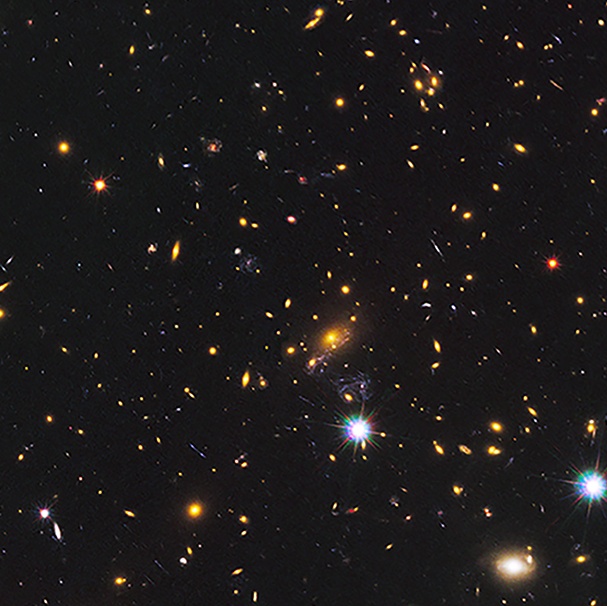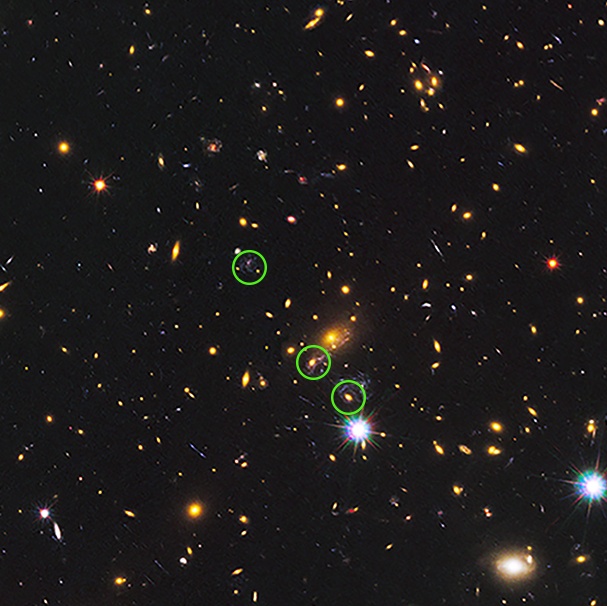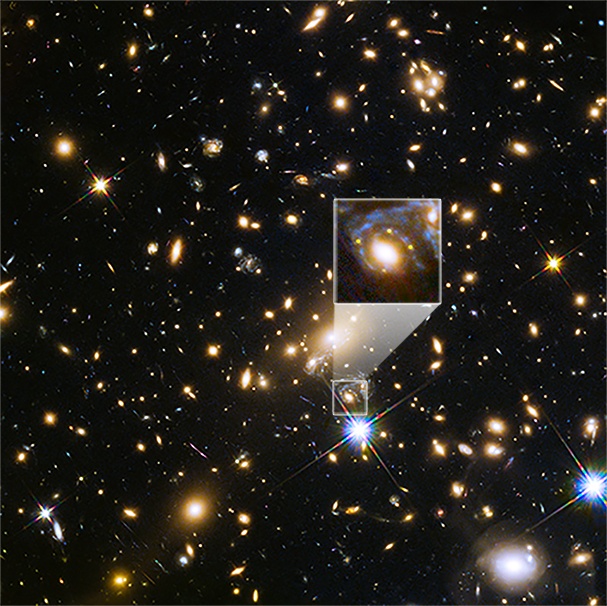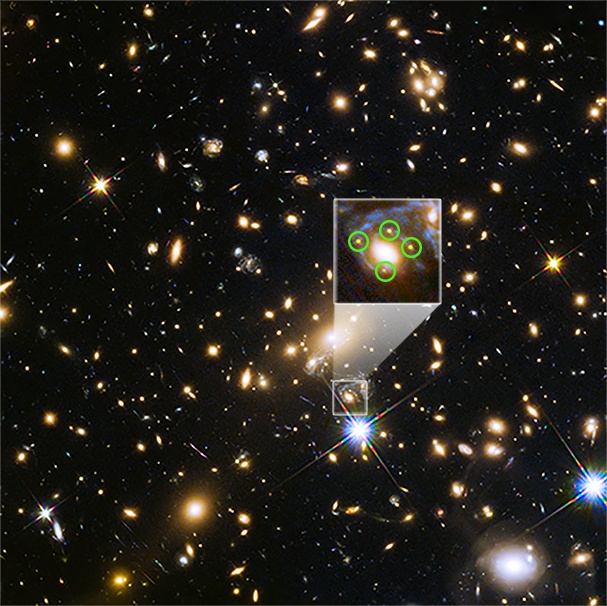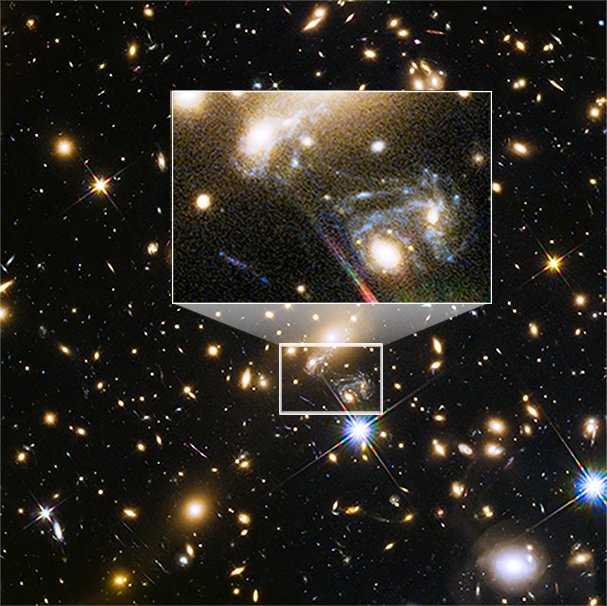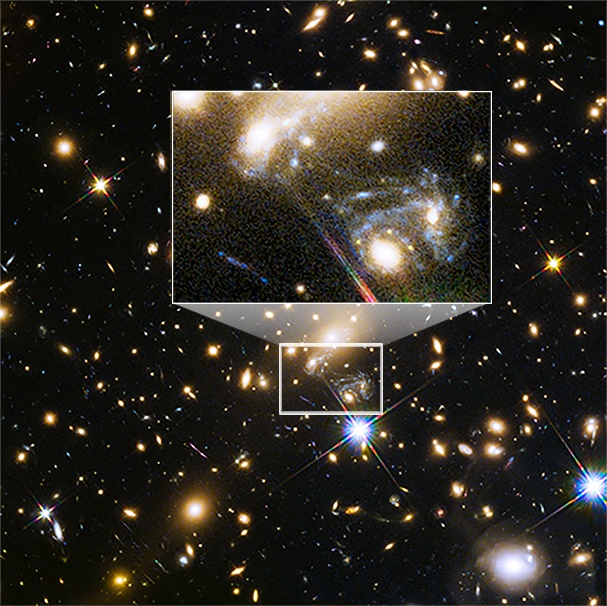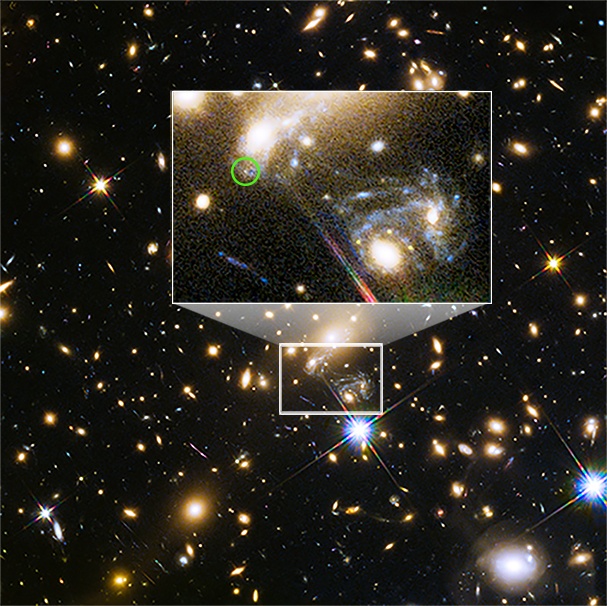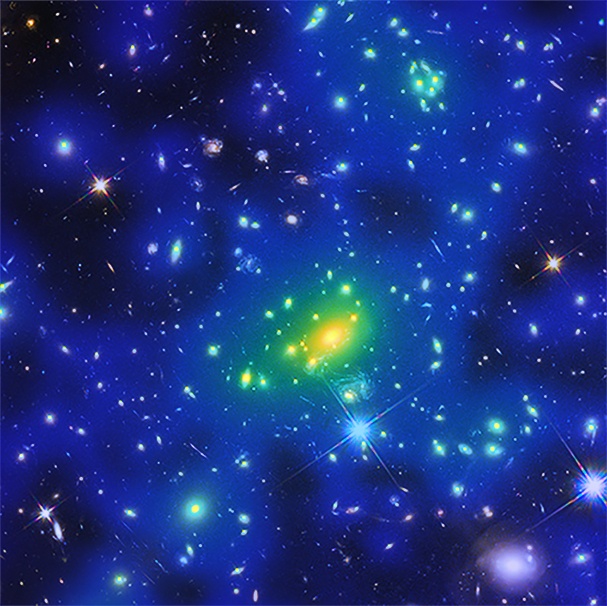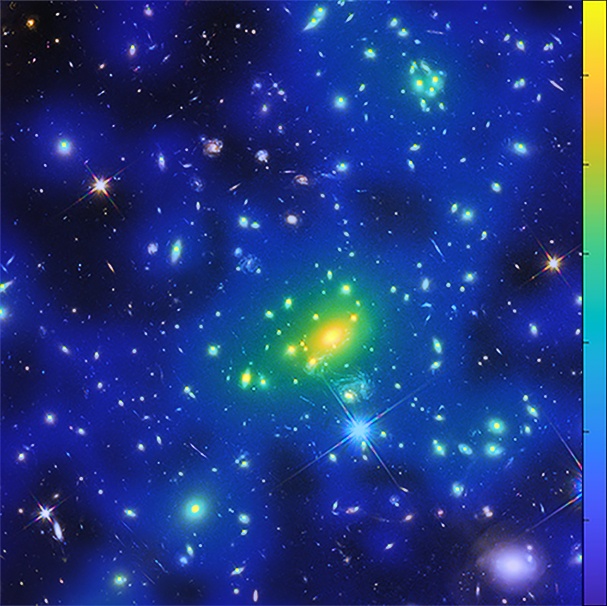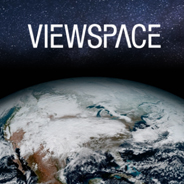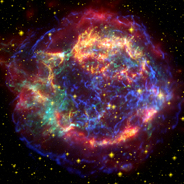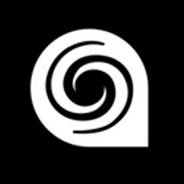Interactive Overview
Slider Interactive: A series of images showing a galaxy cluster located between Earth and Supernova Refsdal over multiple observations. Below the caption is a horizontal slider bar with five labeled stops and a solid white circle. Dragging the white circle right and left along the slider bar causes the image, labels, and caption to change. The change occurs gradually as one image, along with its associated captions and labels, fades out and the next fades in. A toggle button to the upper right of the image turns the image labels off and on. Labels are in the form of text with arrows pointing to specific features in the image. Other labels are graphic overlays.
Slider Stops
From left to right, the slider stops are labeled: Galaxy Cluster, Supernova Discovery, First Follow-up, Supernova’s Reappearance, and The Outcome.
Summary of Slider Stops
Sliding left to right reveals the following:
- “Galaxy Cluster” stop shows a dense field of galaxies against the dark background of space with the same distant galaxy’s appearance in multiple locations highlighted. This is the initial image shown when the interactive is loaded.
- “Supernova Discovery” stop shows the same field of view with a magnified patch of the sky showing the same supernova in multiple locations.
- “First Follow-up” stop shows the same field of view with a magnified patch of the sky with the supernova fading slightly in each of the same locations.
- “Supernova’s Reappearance” stop shows the same field of view with a magnified patch of the sky with the appearance of the supernova in a new location.
- “The Outcome” stop shows the same field of view with the amount of dark matter indicated by different cool tones.
Stop 1: Galaxy Cluster
Image Description: Galaxy Cluster
Image of a black swath of space densely filled with points of light in various sizes and shapes: small dots, thin ellipses, and blobs with fuzzy halos are scattered across the image. Some have diffraction spikes. The objects are in various colors: yellow-white, white, and blue.
Labels: Galaxy Cluster
There is one text label and three graphic overlays. Three small green circles encompass small images of a galaxy that look different in shape and size. The three images appear to show a spiral galaxy distorted in different ways. The locations of these images are roughly diagonal, the first circle is toward the top center left, the second is in the center below a larger object with a fuzzy halo, and the third is in the center right just above a bright blue-white object with diffraction spikes. The circle in the top center left is labeled “Images of same, distant galaxy.”
Caption: Galaxy Cluster
A 2012 image reveals a galaxy cluster is creating multiple, magnified images of a distant galaxy. Is dark matter the culprit?
Stop 2: Supernova Discovery
Image Description: Supernova Discovery
This image reveals the same field of galaxies. Overall, the points of light appear brighter, and more objects have halos or more noticeable diffraction spikes than in the previous stop. A small white square highlights the same area that the lowest green circle encompassed in the prior stop. The small square is connected to a larger one just above, which shows a magnified view of the area. The large square shows a galaxy with a bright yellow-white center and surrounding blue swirl-like wisps. Four small yellow points, which look evenly spaced forming a plus sign shape, surround the galaxy’s center.
Labels: Supernova Discovery
There is one text label and four graphic overlays. Four small green circles highlight the four small yellow points that surround the galaxy’s center in the large square. One of the green circles is labeled “Same supernova seen four times.”
Caption: Supernova Discovery
While studying this galaxy cluster again in November 2014, researchers captured four images of the same supernova in that galaxy.
Stop 3: First Follow-up
Image Description: First Follow-up
This image reveals the same field of galaxies. A small white rectangle highlights the same galaxy as in the previous “Supernova discovery” stop, and some additional area to the left of the galaxy. The small rectangle is connected to a larger one just above, which shows a magnified view of the area: a galaxy with a bright yellow-white center and surrounding blue swirl-like wisps. Four small yellow points, which look evenly spaced, surround the galaxy’s center. Toward the left of the galaxy, the area has other bright points of light, including part of a diffraction spike from a bright star, seen as a thin red streak toward the bottom, and a fuzzy, yellow-white glowing area in the top left.
Labels: First Follow-up
There are two text labels. The fuzzy glowing area in the top left of the magnified view is labeled “Predicted reappearance location.” The galaxy in the magnified view, toward the bottom right, is labeled “Fading supernovas.”
Caption: First Follow-up
Researchers predicted the supernova would appear again elsewhere, but their observations in October 2015 revealed nothing.
Stop 4: Supernova’s Reappearance
Image Description: Supernova’s Reappearance
This image reveals the same field of galaxies. A small white rectangle highlights the same area as in the previous stop, with the magnified view of that area just above. Toward the rectangle’s bottom right corner is a galaxy with a bright yellow-white center and surrounding blue swirl-like wisps. Four small yellow points, which look evenly spaced, surround the galaxy’s center. Toward the left of the galaxy, the area has other bright points of light, including part of a diffraction spike from a bright star, seen as a thin red streak toward the bottom, and a fuzzy, yellow-white glowing area in the top left. Among the hazy bright area in the top left is a small, bright yellow point that was not visible in the prior stop.
Labels: Supernova’s Reappearance
There is one text label and one graphic overlay. A small green circle highlights the small bright yellow point among the fuzzy, yellow-white glowing area in the magnified view’s top left corner. The green circle is labeled “Appears as predicted!”
Caption: Supernova’s Reappearance
In December 2015, they looked again—and caught the supernova’s reappearance, proving some predictions were accurate.
Stop 5: The Outcome
Image Description: The Outcome
This image reveals the same field of galaxies, but transparent hazy splotches of cool colors—bright blue, green, and yellow—now appear. The majority of the image has fuzzy blue blobs dispersed throughout, with pockets of the black background of space. The center of the image, near the supernova’s location, is bright yellow and green.
Labels: The Outcome
There are three text labels and one graphic overlay. A bright blue area among the center left is labeled “Dark matter.” A vertical gradient bar on the right of the image shows yellow toward the top, green-blue in the middle, and blue toward the bottom. The yellow area at the top of the bar is labeled “More dark matter.” The blue area at the bottom is labeled “Less dark matter.” The overlay suggests that there is more dark matter toward the center of the cluster and that the dark matter is unevenly distributed, forming halos around larger galaxies.
Caption: The Outcome
Researchers used dark matter models to correctly predict the supernova’s reappearance, refining our understanding of its distribution.
